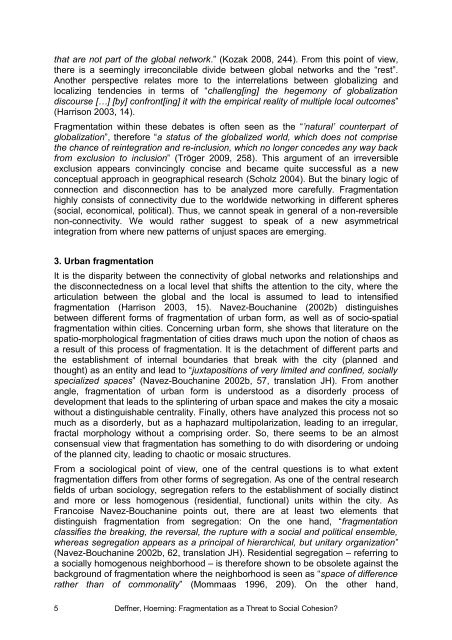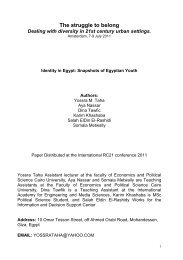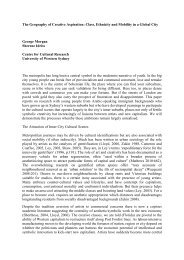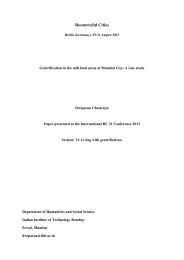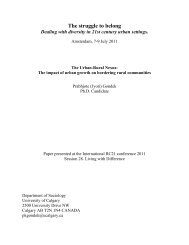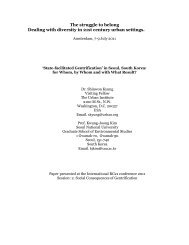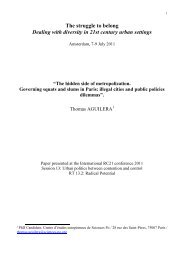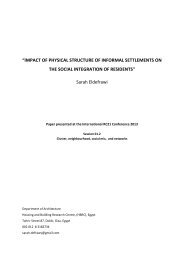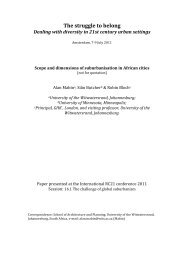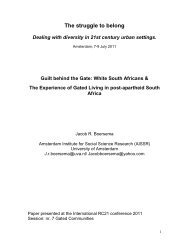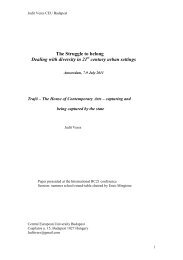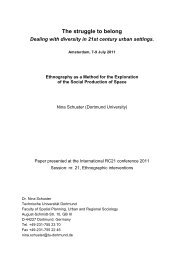Fragmentation as a threat to social cohesion - RC21 ORG ...
Fragmentation as a threat to social cohesion - RC21 ORG ...
Fragmentation as a threat to social cohesion - RC21 ORG ...
Create successful ePaper yourself
Turn your PDF publications into a flip-book with our unique Google optimized e-Paper software.
that are not part of the global network.” (Kozak 2008, 244). From this point of view,<br />
there is a seemingly irreconcilable divide between global networks and the “rest”.<br />
Another perspective relates more <strong>to</strong> the interrelations between globalizing and<br />
localizing tendencies in terms of “challeng[ing] the hegemony of globalization<br />
discourse […] [by] confront[ing] it with the empirical reality of multiple local outcomes”<br />
(Harrison 2003, 14).<br />
<strong>Fragmentation</strong> within these debates is often seen <strong>as</strong> the “’natural’ counterpart of<br />
globalization”, therefore “a status of the globalized world, which does not comprise<br />
the chance of reintegration and re-inclusion, which no longer concedes any way back<br />
from exclusion <strong>to</strong> inclusion” (Tröger 2009, 258). This argument of an irreversible<br />
exclusion appears convincingly concise and became quite successful <strong>as</strong> a new<br />
conceptual approach in geographical research (Scholz 2004). But the binary logic of<br />
connection and disconnection h<strong>as</strong> <strong>to</strong> be analyzed more carefully. <strong>Fragmentation</strong><br />
highly consists of connectivity due <strong>to</strong> the worldwide networking in different spheres<br />
(<strong>social</strong>, economical, political). Thus, we cannot speak in general of a non-reversible<br />
non-connectivity. We would rather suggest <strong>to</strong> speak of a new <strong>as</strong>ymmetrical<br />
integration from where new patterns of unjust spaces are emerging.<br />
3. Urban fragmentation<br />
It is the disparity between the connectivity of global networks and relationships and<br />
the disconnectedness on a local level that shifts the attention <strong>to</strong> the city, where the<br />
articulation between the global and the local is <strong>as</strong>sumed <strong>to</strong> lead <strong>to</strong> intensified<br />
fragmentation (Harrison 2003, 15). Navez-Bouchanine (2002b) distinguishes<br />
between different forms of fragmentation of urban form, <strong>as</strong> well <strong>as</strong> of socio-spatial<br />
fragmentation within cities. Concerning urban form, she shows that literature on the<br />
spatio-morphological fragmentation of cities draws much upon the notion of chaos <strong>as</strong><br />
a result of this process of fragmentation. It is the detachment of different parts and<br />
the establishment of internal boundaries that break with the city (planned and<br />
thought) <strong>as</strong> an entity and lead <strong>to</strong> “juxtapositions of very limited and confined, <strong>social</strong>ly<br />
specialized spaces” (Navez-Bouchanine 2002b, 57, translation JH). From another<br />
angle, fragmentation of urban form is unders<strong>to</strong>od <strong>as</strong> a disorderly process of<br />
development that leads <strong>to</strong> the splintering of urban space and makes the city a mosaic<br />
without a distinguishable centrality. Finally, others have analyzed this process not so<br />
much <strong>as</strong> a disorderly, but <strong>as</strong> a haphazard multipolarization, leading <strong>to</strong> an irregular,<br />
fractal morphology without a comprising order. So, there seems <strong>to</strong> be an almost<br />
consensual view that fragmentation h<strong>as</strong> something <strong>to</strong> do with disordering or undoing<br />
of the planned city, leading <strong>to</strong> chaotic or mosaic structures.<br />
From a sociological point of view, one of the central questions is <strong>to</strong> what extent<br />
fragmentation differs from other forms of segregation. As one of the central research<br />
fields of urban sociology, segregation refers <strong>to</strong> the establishment of <strong>social</strong>ly distinct<br />
and more or less homogenous (residential, functional) units within the city. As<br />
Francoise Navez-Bouchanine points out, there are at le<strong>as</strong>t two elements that<br />
distinguish fragmentation from segregation: On the one hand, “fragmentation<br />
cl<strong>as</strong>sifies the breaking, the reversal, the rupture with a <strong>social</strong> and political ensemble,<br />
where<strong>as</strong> segregation appears <strong>as</strong> a principal of hierarchical, but unitary organization”<br />
(Navez-Bouchanine 2002b, 62, translation JH). Residential segregation – referring <strong>to</strong><br />
a <strong>social</strong>ly homogenous neighborhood – is therefore shown <strong>to</strong> be obsolete against the<br />
background of fragmentation where the neighborhood is seen <strong>as</strong> “space of difference<br />
rather than of commonality” (Momma<strong>as</strong> 1996, 209). On the other hand,<br />
5 Deffner, Hoerning: <strong>Fragmentation</strong> <strong>as</strong> a Threat <strong>to</strong> Social Cohesion?


